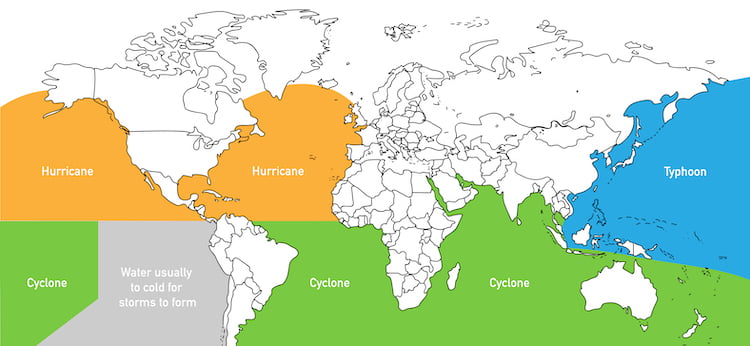
Depending on the part of the country in which you live, you may hear different terms being used for everyday items. For example, “soda” is a term most people in the U.S. know about. However, people in the Midwest may be more accustomed to “pop”. These differences are common not only throughout the various regions of the U.S. but also throughout the world for a variety of situations.
Take for example tropical storms like the cyclone, hurricane, and typhoon. Many people might ask themselves “What is the difference between a cyclone, hurricane, and typhoon?” and with good reason, since these terms sound different at a glance. However, these three storms have a lot more in common than you might expect, and it all comes down to the region where they occur.
What is a Hurricane?
Hurricanes are tropical storms that originate in the North Atlantic, central North Pacific, and the eastern North Pacific oceans. Hurricanes have maximum sustained surface winds of 74 mph or greater. In addition to the high winds, hurricanes also produce heavy rainfall, storm surges, flash floods and tornadoes, all of which can cause devasting property damage.
‘Hurricane’ is likely the tropical cyclone term with which you are most familiar. These tropical storms happen regularly throughout hurricane season, causing significant damage to property in coastal regions.
What is a Typhoon?
Typhoon is the term used for a tropical cyclone that is located in the northwest Pacific Ocean, close to the Philippines, Japan and China. Similar to hurricanes, typhoons have sustained surface winds around 74 mph, and produce heavy rainfall and storm surges.
Typhoon season in the Northwestern Pacific Basin is from January through December, and in the Southwestern Pacific Basin it is from July of one year through June of the next. There are no seasonal boundaries for typhoons, and they form year round, although typically they develop the most between May and October.
The Japan Meteorological Society is in charge of naming typhoons and other major storms in the western North Pacific and South China Sea. Only storms that are tropical storm level and above are named.
What is a Cyclone?
The generic term cyclone is used to describe a tropical cyclone that originates in the South Pacific and Indian oceans.
Similar to hurricanes and typhoons, there are seasons where cyclones are the most frequent throughout these regions:
- The South Pacific cyclone season is at its peak from January through March.
- The Northern Indian Ocean cyclone season is unique because it has two peaks, one from April through June and the second from September through December. Between these two peak periods, there are very few tropical cyclones.
- The Southeast Indian Ocean cyclone season is from November 15 through April 30.
Cyclone vs. Hurricane vs. Typhoon
As you might have noticed,hurricanes, cyclones, and typhoons are all types of tropical cyclones. The main difference between these terms is where the tropical cyclone originates, with each region having a separate name for these storms:

- Hurricanes originate in the North Atlantic, central North Pacific and the eastern North Pacific oceans.
- Typhoons originate in the Northwest Pacific Ocean, close to the Philippines, Japan and China.
- Cyclones originate in the South Pacific and Indian oceans.
While cyclones, hurricanes, and typhoons are the same type of tropical storm, but there are additional differences in how they are classified. Each region has their own classification system led by the official warning center located in that area. Hurricanes have five categories of strength, cyclones have three to five categories of strength, while typhoons have two to three categories of strength.
While the main differences between a cyclone, hurricane, and typhoon are their locations and how they’re categorized, there is the question of what happens when a storm passes into another region. Will a hurricane continue to be called a hurricane in another region?
This very set of circumstances occurred in 2014 when Genevieve first formed in the central Pacific as a depression, became a major hurricane in the central Pacific called Hurricane Genevieve and then moved into the western Pacific as a super typhoon called Typhoon Genevieve. Although the tropical cyclone terms changed, Genevieve remained the storm’s name throughout.
No Matter the Name, Tropical Storms Can Cause Costly Damage
Regardless of the name or location, tropical storms can cause extensive damage to your home. If you live in an area prone to hurricanes, take the necessary steps to make sure you are prepared, including creating a preparedness plan.
If your home is damaged during a tropical storm, ServiceMaster Restore is ready to help. We offer tropical storm damage restoration services for your home that will help you get back to normal as quickly as possible. We also have more than 850 locations across the United States that are locally owned and operated.
Call 1-800-RESPOND to reach our disaster response center 24 hours a day, 7 days a week, 365 days a year.